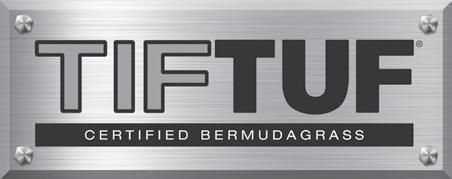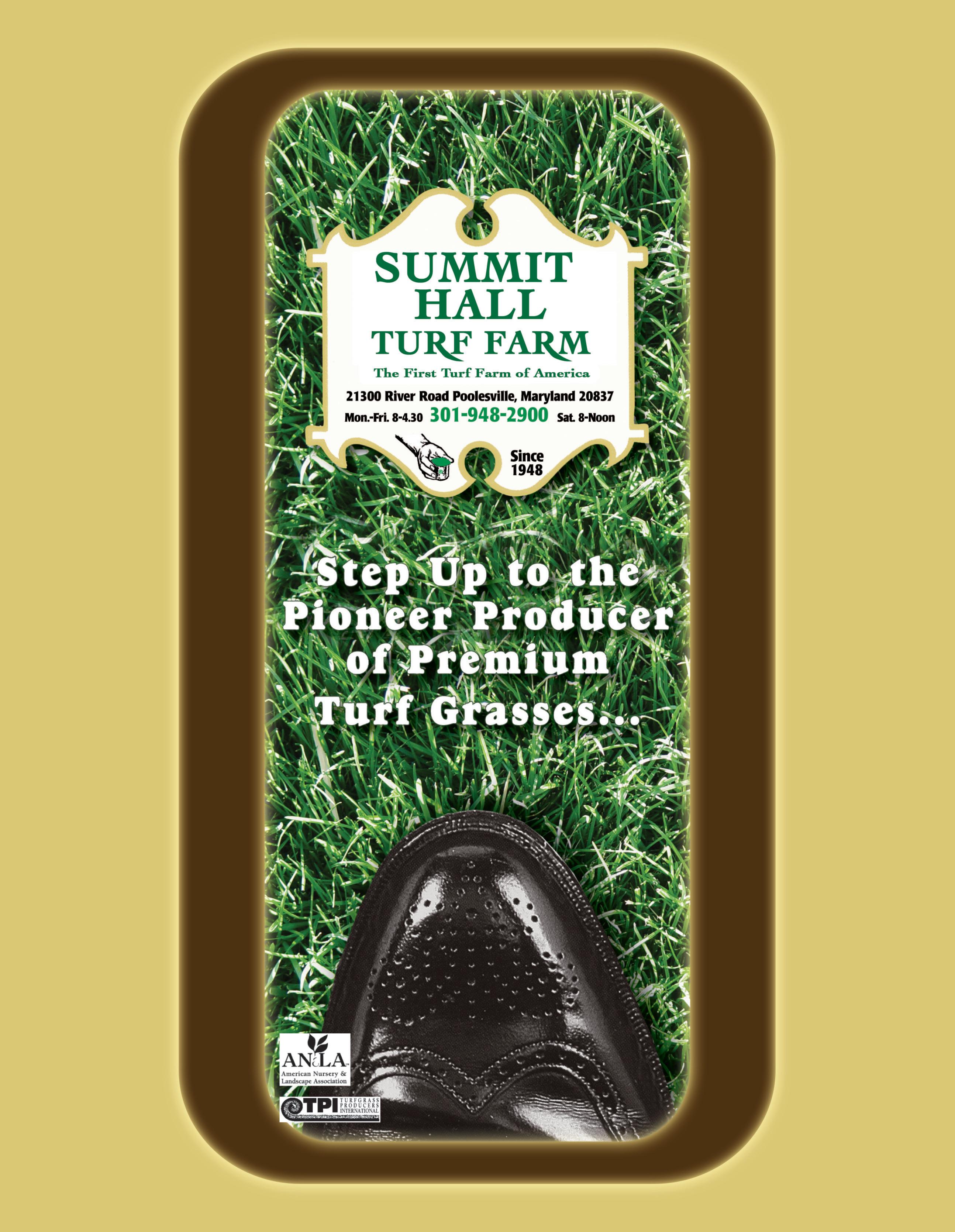Cheryl Gaultney





































































































Rick Boldissar
& Seed Section
Harry S Truman Parkway
MD 21401
410-841-5968
Cell: 443-791-2896
Harry S Truman Parkway Annapolis, MD 21401
kelly.love@maryland.gov
is that time of year again to start planning for re-certifications. As we move through the busiest time of the year, it’s also time to start looking into the future. The MTC will be having our biggest event of the year on December 13th, 2022. It will be held at the Turf Val ley CC and Resort once again. You can register online, by email, fax, or U.S. Mail in your forms you will receive in the mail to the MTC address provided. This conference is a great opportunity to network, learn, and get re-certifications for pesticide and fertilizer applicators. The credits ob tained cover multiple states and several categories as well. The trade show is also a wonderful opportunity to meet and mingle with some of the area’s leading vendors and suppliers. I am looking forward to seeing you there!
In other MTC news… We have partnered with Percy Public Affairs, a premier lobbying firm, to help us stay ahead of the current and future gov ernmental restrictions, bans, and legislation that our industry is facing. The goal of this relationship is to have more individuals in our corner that will be looking out for the best interests of our companies, organizations, and our customers. This, along with our collaborations and close relationship with MASTMA and SFMA, we are all striving to be the best that we can be for Maryland and its surrounding states.
There is an informative presentation planned for immediately after lunch at the conference and of course there will be more information to come as we move closer to the legislative sessions.
Lastly, I want to give a big thanks to the University of Maryland and their research team for hosting the Field Plot Walk in July. Although it was a sweltering day, the turnout was great. We ended the day with great food, conversations, and a couple of cold drinks. I look forward to doing this event again next year!!
As always, keep those memberships coming in, and look for more train ing and networking opportunities to come in the upcoming months.
Best regards, and let’s keep growing together.
Your President,
Harry S Truman Parkway Annapolis, MD 21401
judy.mcgowan@maryland.gov
Dr. Mark Carroll

& Pesticides
Plant Science Bld. College Park, MD 20742
301-405-1339
Farm: 301-314-6303 mcarroll@umd.edu
Dr. Thomas Turner, Professor Emeritus Turfgrass Nutrients / Extension
Green Meade Dr. College Park, MD 20740-3721 Farm: 301-314-6302
tturner@umd.edu
Dr. Peter Dernoeden Professor Emeritus
White Oak Dr.
DE

Plant Science Bld.
Fieldhouse Dr., College Park, MD
Green Meade Dr.
Park, MD 20740-3721
Management
Jull Hall
Stadium Dr.
Park, MD
Dr. Kevin Mathias Professor Emeritus
Park, MD
jkm@umd.edu
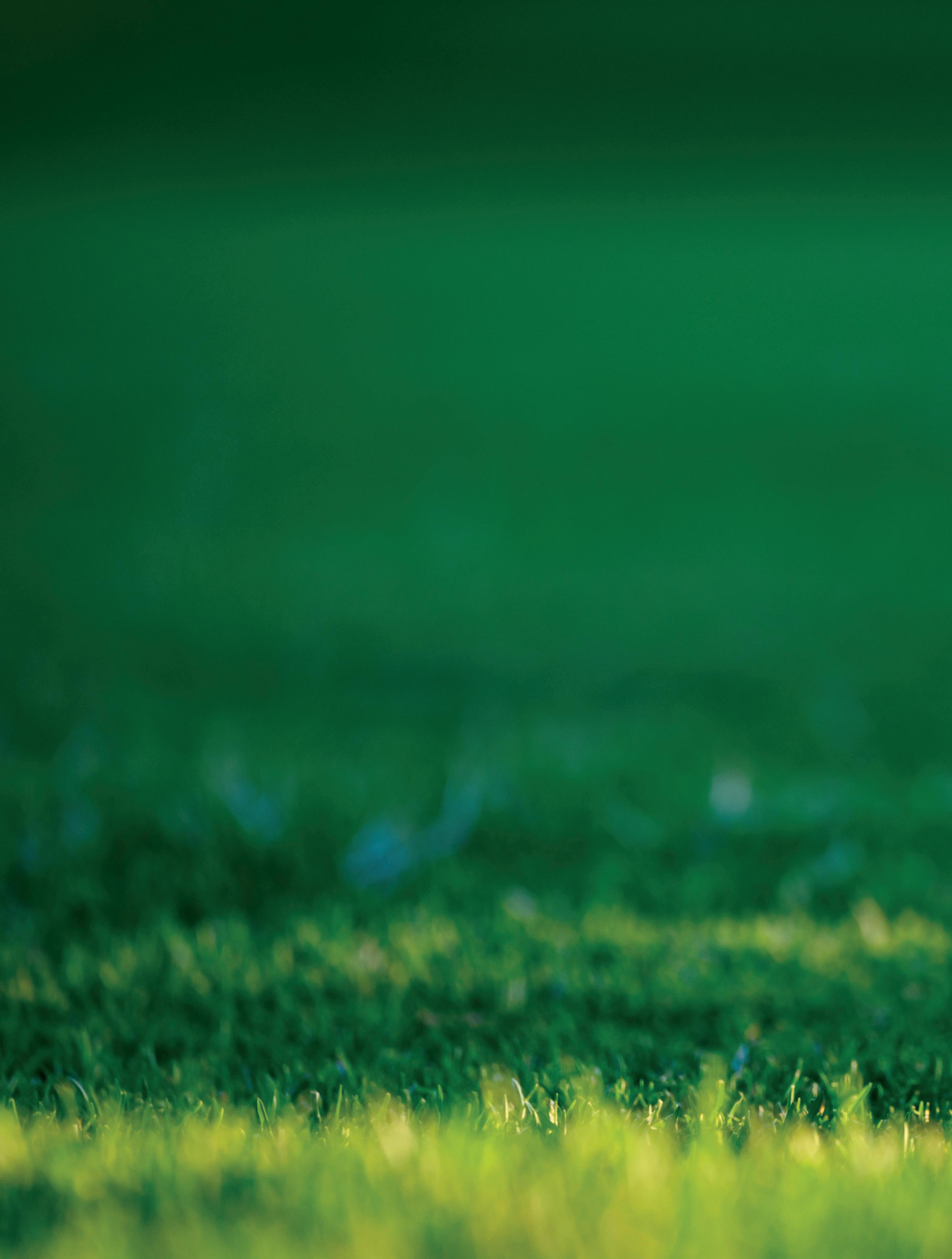
Please mark your calendars and complete your pre-regis tration form to attend a fabulous Educational Program and Trade Show all dedicated to Cheryl Gaultney, our secretary for 46 years. Once again, we are going to be at the premier facilities at Turf Valley Resort & Golf Course in Ellicott City, MD. You can find your pre-registration form on page 19 in this magazine or watch for the pre-registration packet that is being sent directly to you. Look on the preregistration form, page 19 for a new pre-reigstration schedule to save you money and hopefully avoid the rush the morning of the conference.
Our conference is LIVE this year, however, if you are feeling ill or still having fears of large groups, you can still attend the “Lawn & Landscape Management Track” vir tually with zoom. However, you will miss the Trade Show, fine food and the networking opportunities only available at the LIVE conference. Please indicate on your conference registration form if you cannot join us.
Also, on the pre-registration form or the sponsor/vendor form, please see the question asking, “Do you prefer receiving notices and forms by email or U.S. Mail?” Several members have asked to have notices and forms e-mailed to them instead of sending it through the U.S. Mail. We have already started a new email contact group for those preferring email. If you choose email, all will come in that form except the quarterly MTC Turf News Magazine.
As of September 25, we already have seven vendors and a sponsor, but there is still plenty of room for you to be a vendor and show us all your wares. If you prefer to support the University Turfgrass Research Program, we can always use many sponsors to help reduce the cost of the conference and increase the funding we have to support the turfgrass programs. Just complete the form on page 21 and send it in ASAP to receive the best pricing. Thank you for your support.
Don’t miss the “Quilt for Research Raffle” on page 18. These top-quality lap quilts are fantastic for watching TV, sitting by a bonfire, or just snuggling with a loved one. These are designed and constructed by Katy, our treasurer. This year’s quilt has Black-eyed Susans as the center of each square. It is approximately 50" x 63" and is valued between $550 to $600. John Shields won last year, and Diana Patton won the year before. Tickets are $10 each or 3 for $20 and the drawing will occur at the MTC General Meeting right after lunch.
Have you ever considered being part of the MTC Board? We are in need of a secretary; 46 years’ experience is NOT a requirement but some of the secretary’s duties are:
• Keep a complete record of all meetings of the MTC Annual General Meetings, monthly Board of Directors meetings, and any special meetings which may be called (generally 12 –14 per year with many being by Zoom).
• Maintain the meeting records of the MTC, with a duplicate copy maintained by the ex ecutive director.
• Provide notices of all meetings to all board members and advisors, accumulate the re sponses to ensure a quorum will be available for the meetings.
• Assist the executive director, treasurer and others with registration and sign-in at the Annual Winter Conference, Regional Pes ticide / Fertilizer Recertification Classes, Uni versity of Maryland Field Days or other such activities as needed (perhaps 3 – 5 per year).
•
Coordinate other activities with the executive director that may be necessary.
• The term of the secretary is 2 years, but you may be re-elected if desired at the Annual Conference.
If you think you would like to get involved, please contact any MTC Board Member or give me a call.
Looking forward to seeing you at Turf Valley, Vernon Cooper MTC Executive Director
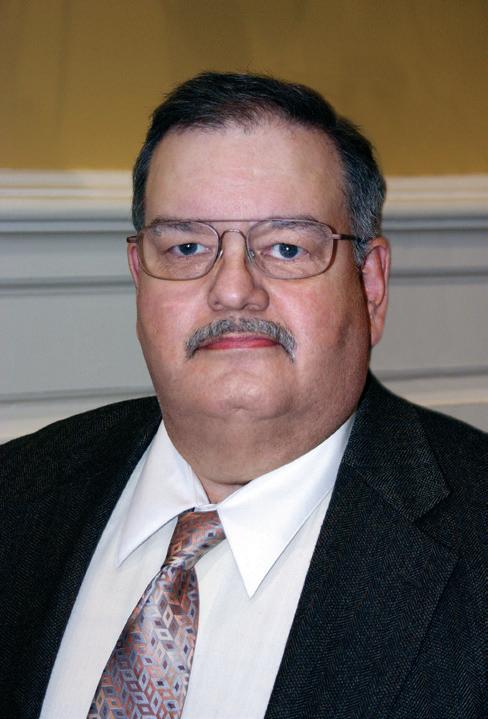



OnSunday June 26, 2022, the MTC suffered a significant loss when we lost our secretary of 46 years, Cheryl A. Gaultney, who had also served as our treasurer for 41 of those years before being called home to be with her Lord and Maker.

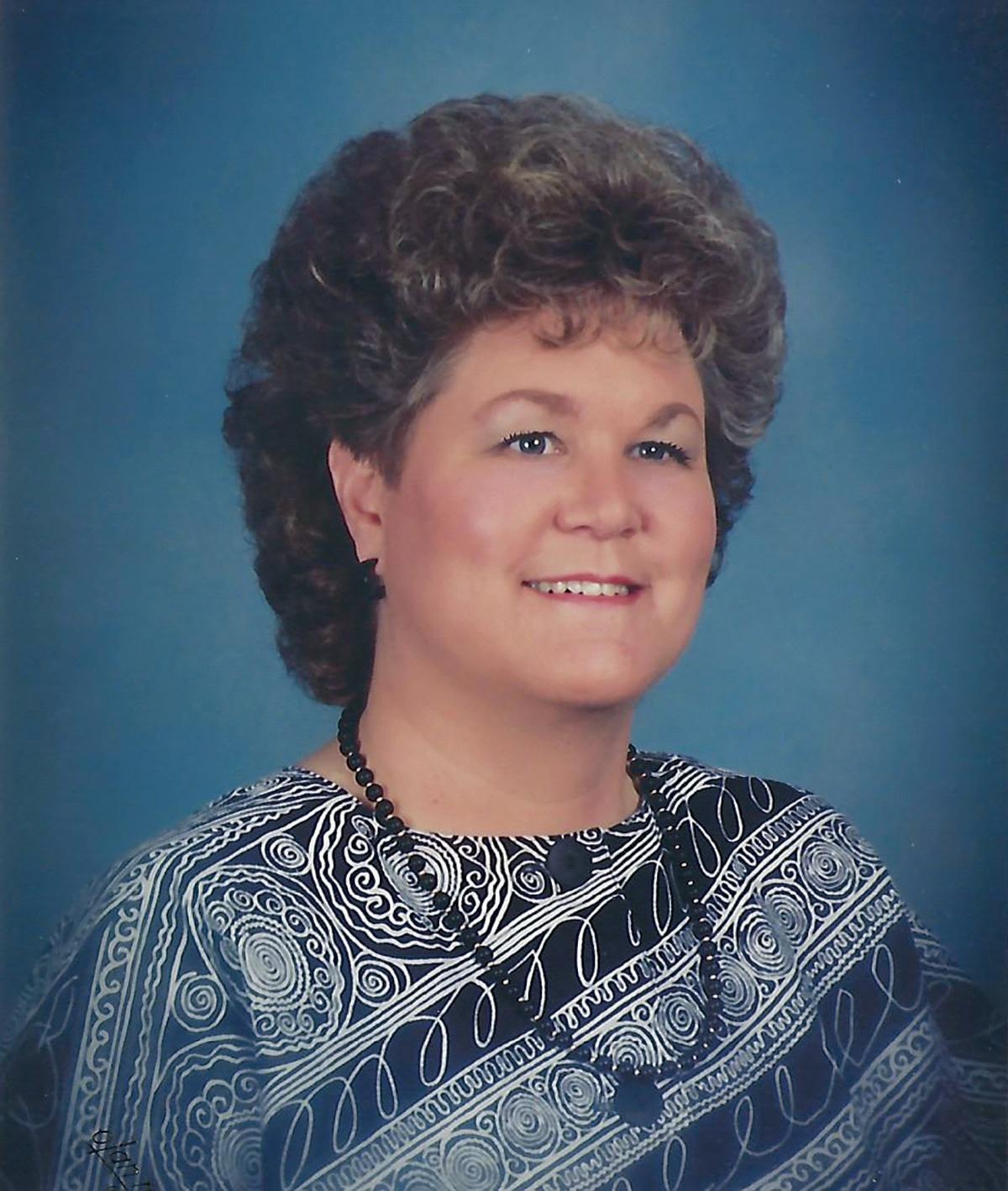
But more importantly we all lost a pillar to the entire turfgrass industry, a guide, an aide to all, and a very dear friend and supporter to all!
Back in 1972 the MTC was formed by the golf course superintendents and the sod farmers, with the help of the University of MD Turfgrass Professionals and those of the State Board of Agriculture to promote quality turf usage and environ mentally sound turfgrass management practices, plus support the turfgrass research at the university and promote the use of MD Certified Sod.

In January 1975 we had our first MTC Annual Winter Turfgrass Conference at the Sheraton in Landover. It was a chilly trade show in the outside parking garage, but it was a great success.
Cheryl missed our first Winter Conference but was in troduced to the MTC Board at the first board meeting in 1975 by her stepfather, John Strickland, who was the owner of Egypt Farms and where Cheryl worked with her mom, Veronica (Woppman) Strickland as a secretary and dispatcher.
Cheryl was a married young lady when she came to us, having met the love of her life Basil (Hicks) Gaultney one evening in 1971 while at a social club. This union made by God resulted in a beautiful daughter Kellye and three fantastic grandchildren Kenzie, Trystan, and Dalton. Cheryl was a loving and devoted wife, mother, grandmother, sister, cousin, aunt and friend who was happiest when spending time with others.
The MTC Annual Turfgrass 2022 Conference & Trade Show is Dedicated to: Cheryl A. Gaultney
26, 2022

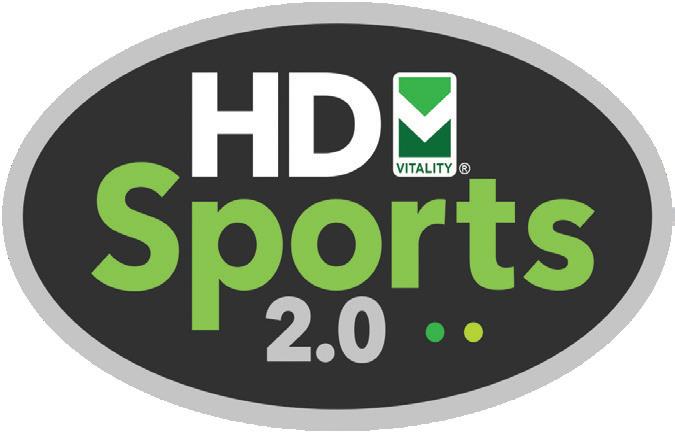

Cheryl grew up in Perry Hall, Maryland and was still active with her graduating class.
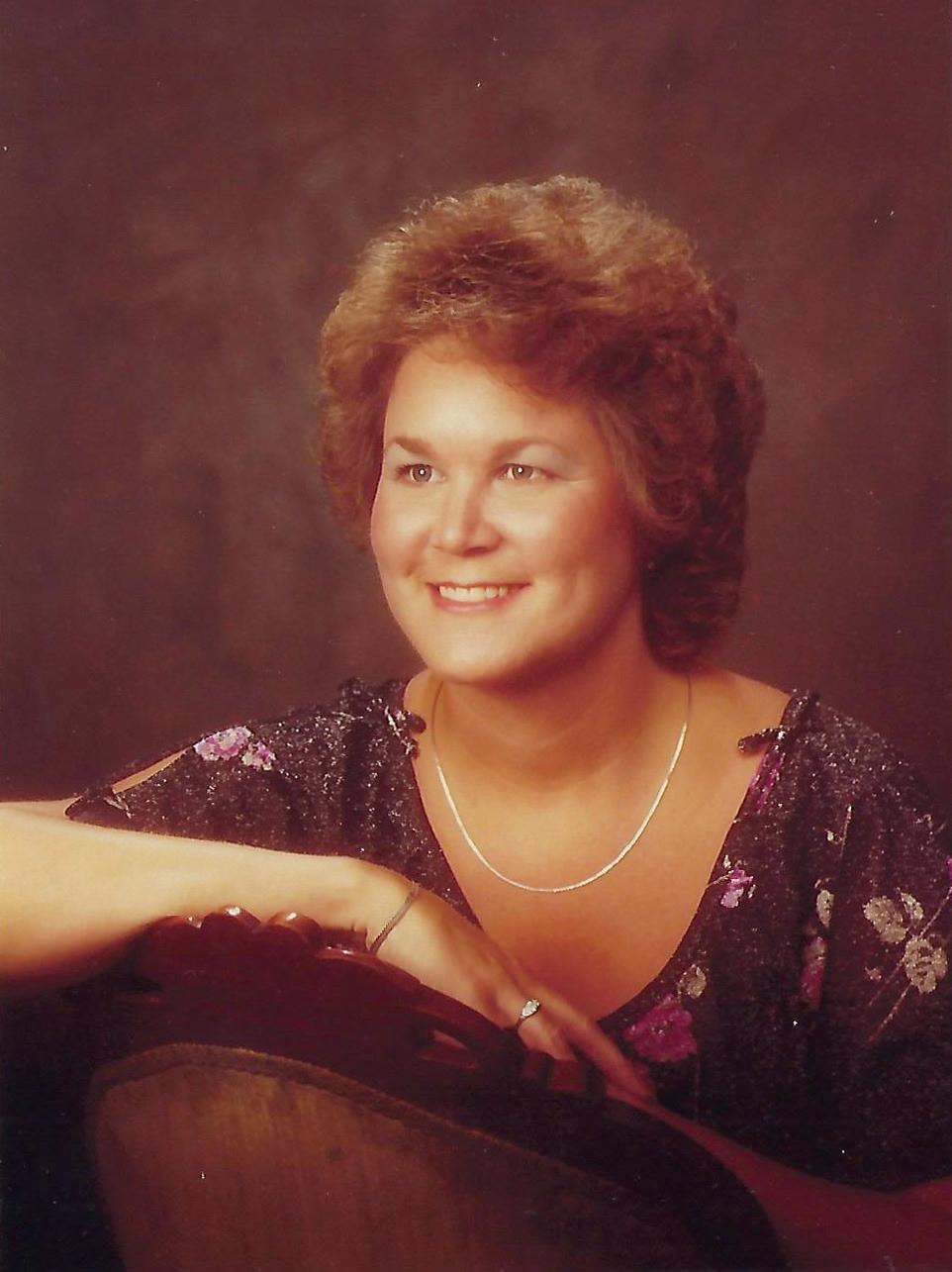
She was a 40+ year member of St. Matthew Lutheran Church where she served in various roles, most notably in the church’s youth program including Sunday School, Vacation Bible School, and organizing the college care program for students studying away from home. Cheryl and Basil often opened their home for the youth program of the church.
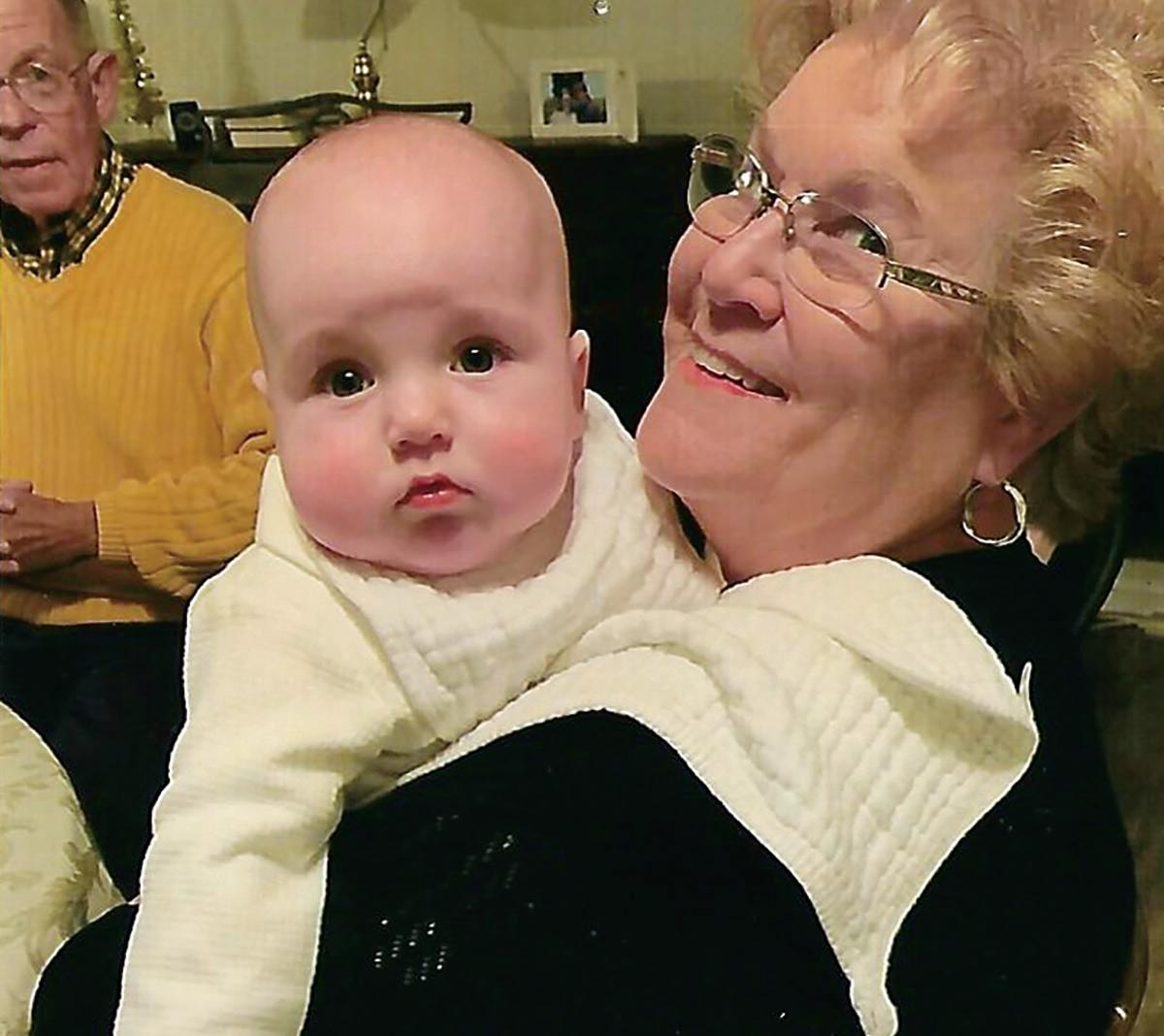
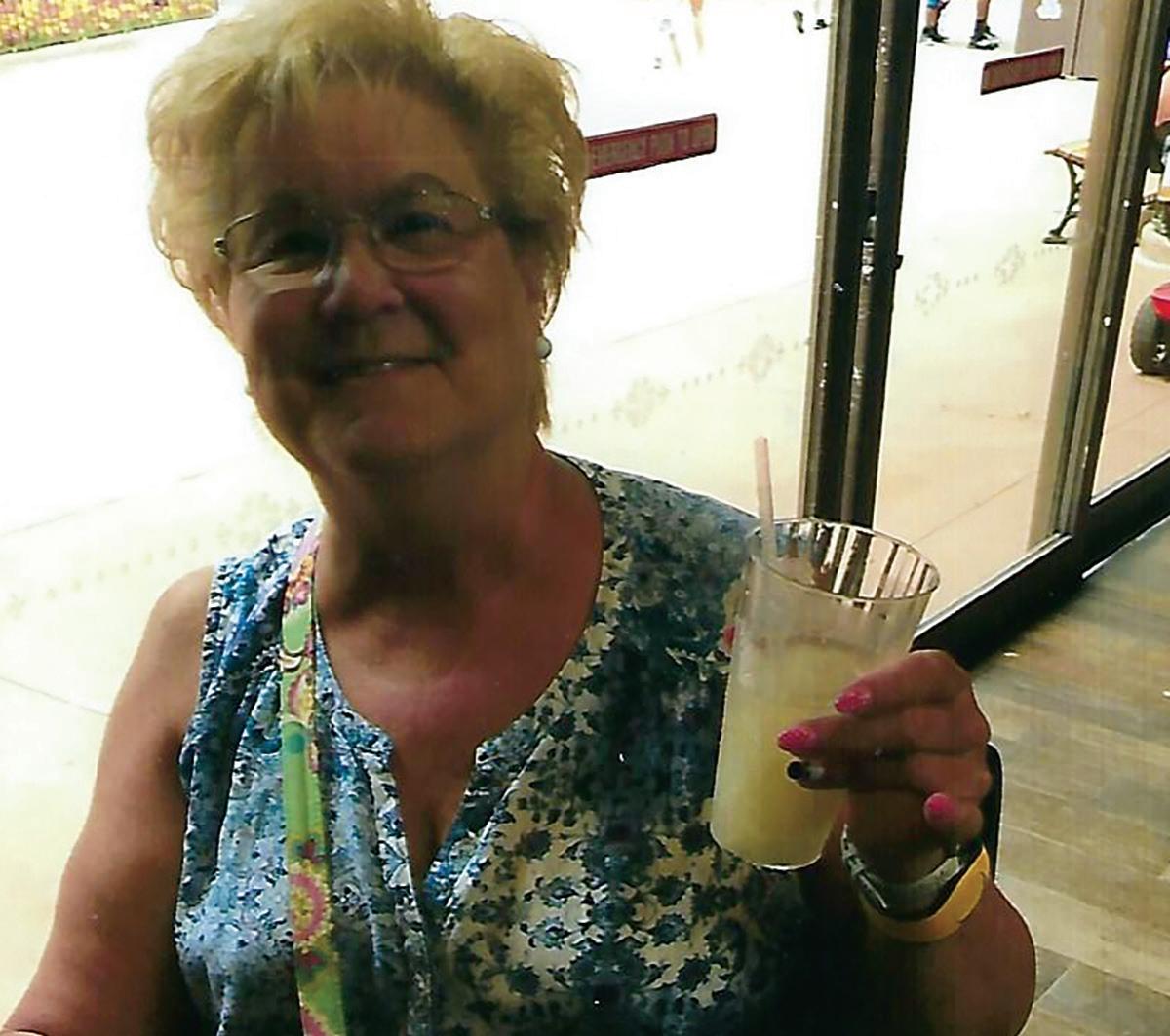

But we as members of the MTC, and especially those who had the pleasure of serving as an officers or as members of the board of directors with Cheryl over the last 46 years, remember Cheryl as always having a smile, a kind word and even the oc casional hug. She was a pillar not only to the MTC but to the entire turfgrass industry in Maryland. It made little difference whether we were sponsoring a multi-day conference at the Con vention Center in Baltimore or University of Maryland Field Days, or a MTC sponsored Pesticide and Fertilizer Applicator License Recertification Program, you could bet Cheryl was there not just running registration, but she was the anchor that caused many of these events to be so successful. As a board member recently said after her death, “It will just not be the same having MTC events and not have Cheryl there.” I’m certain that Cheryl will always be looking down from heaven making sure all runs smoothly.
Cheryl was extremely organized and was a walking library anytime a question or concern was raised in our monthly board of directors meetings, Cheryl either knew the answer or knew where to find the answer. Cheryl was elected secretary/treasurer in January 1975 and served right up until her death. She turned over the financial books and the position of treasurer just five years ago, wanting to remain on the board as secretary.
Prior to Covid, when we were meeting monthly, usually at MDA, Cheryl would always make sure we had a snack, occa sionally homemade, and a cold drink to get through the 4pm meetings to hold us from starvation until we could get home or go to a local restaurant to relax and have dinner instead of fighting rush hour traffic.
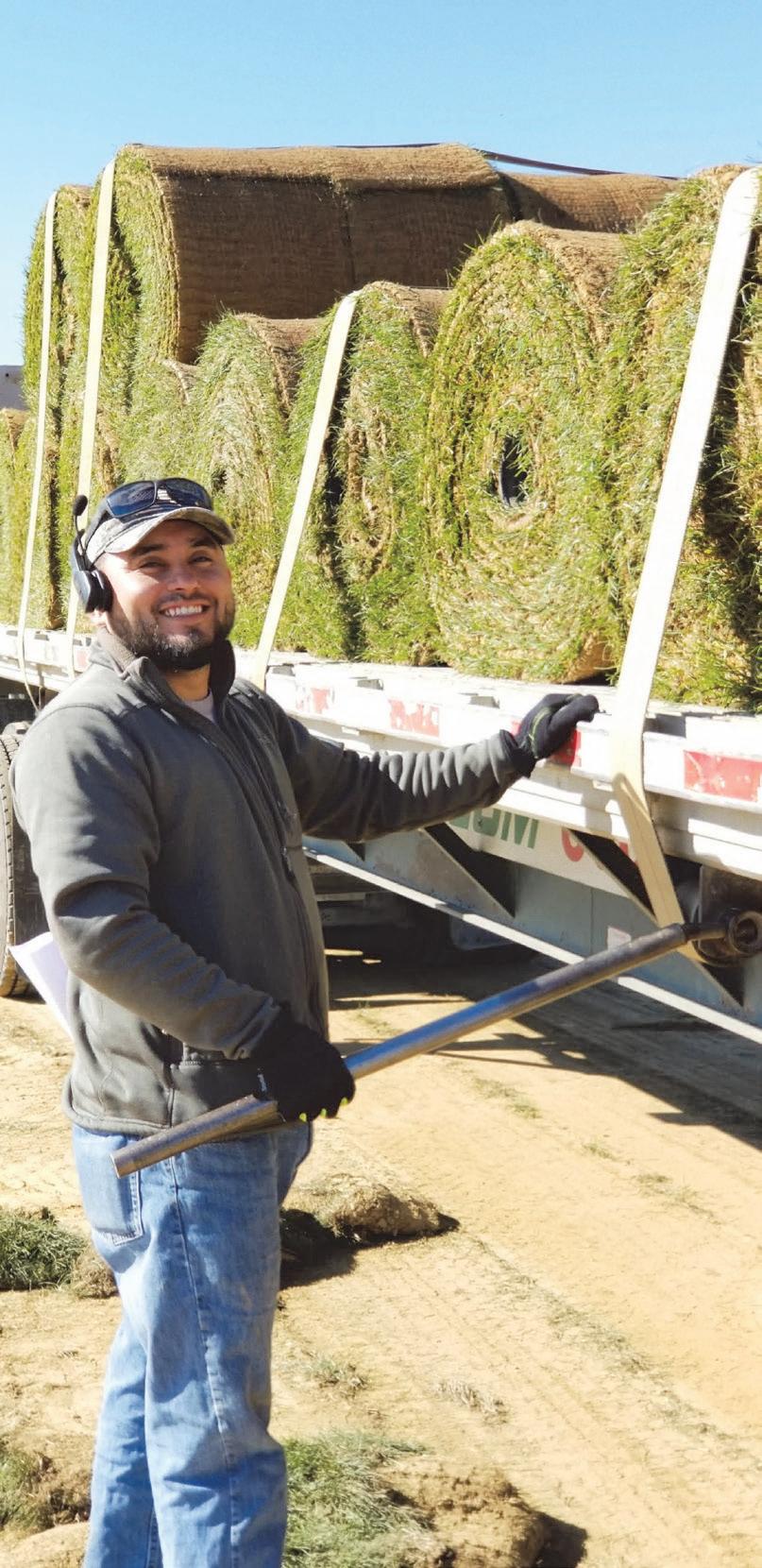


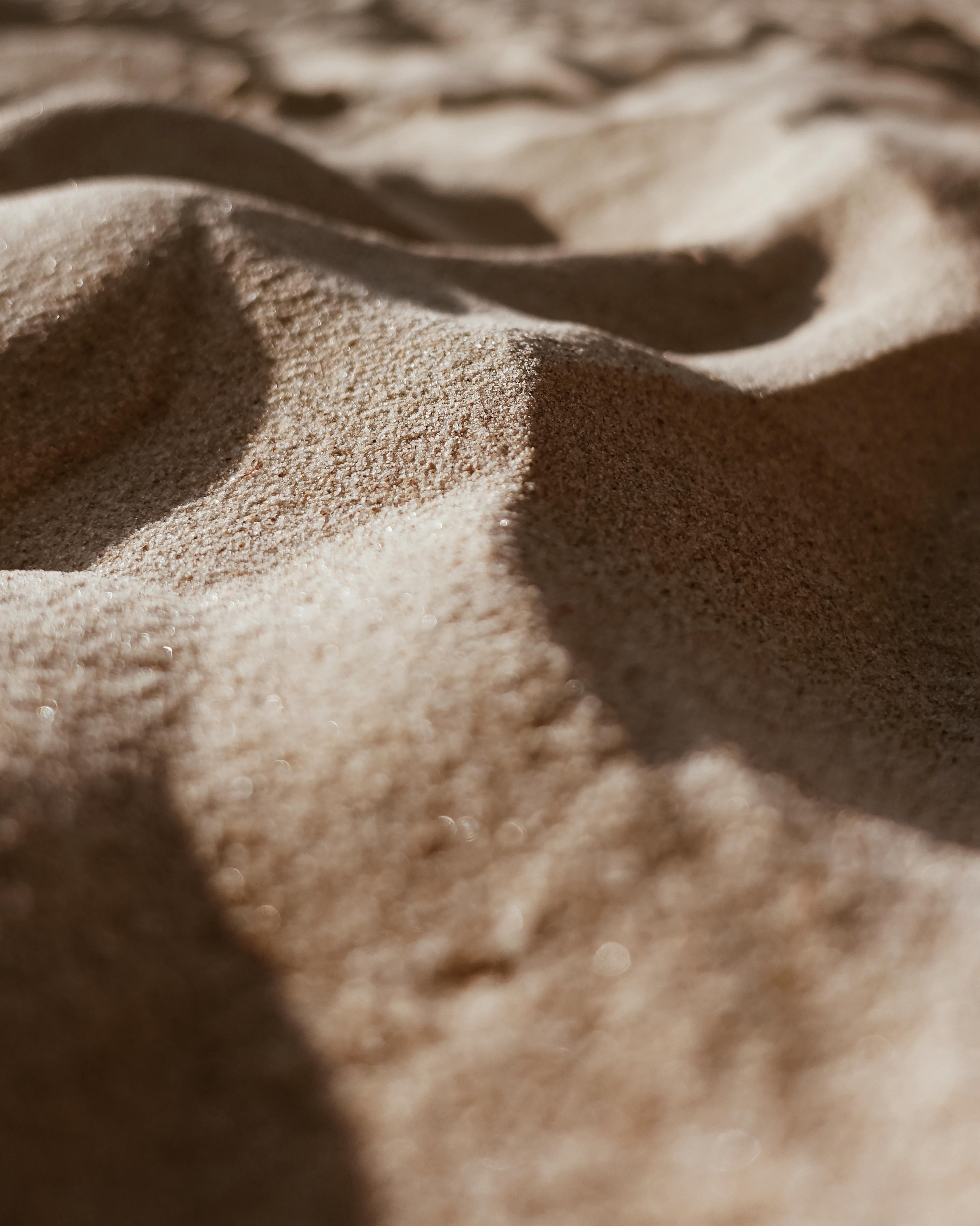
Charter Member, Past MTC President (2003–2004), and previous employee of Egypt Farms, Dave Cammarota said of Cheryl, “She was just amazing in her talents, and I can’t imagine what life would have been like without her input, kindness, and assistance to me as President and all the others with whom she served on the board of directors. The passing of Cheryl Gaultney has been a major shock to me and many of her asso ciates when we learned of her death. She will be sorely missed!”
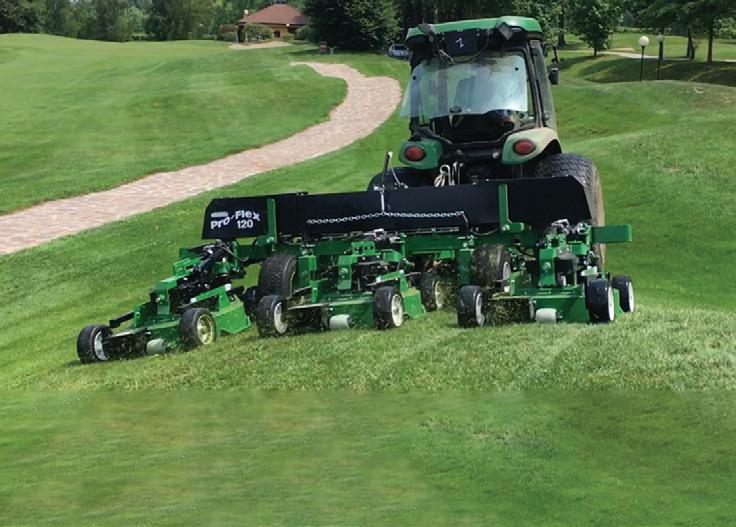


Cheryl has gone on to spend eternity with her Lord and Maker, but she certainly has touched more individuals than we will ever know about, but we will be thinking of her often. She will never be forgotten as long as we, her friends and loved ones, are still on this earth. We are all blessed for knowing her. •
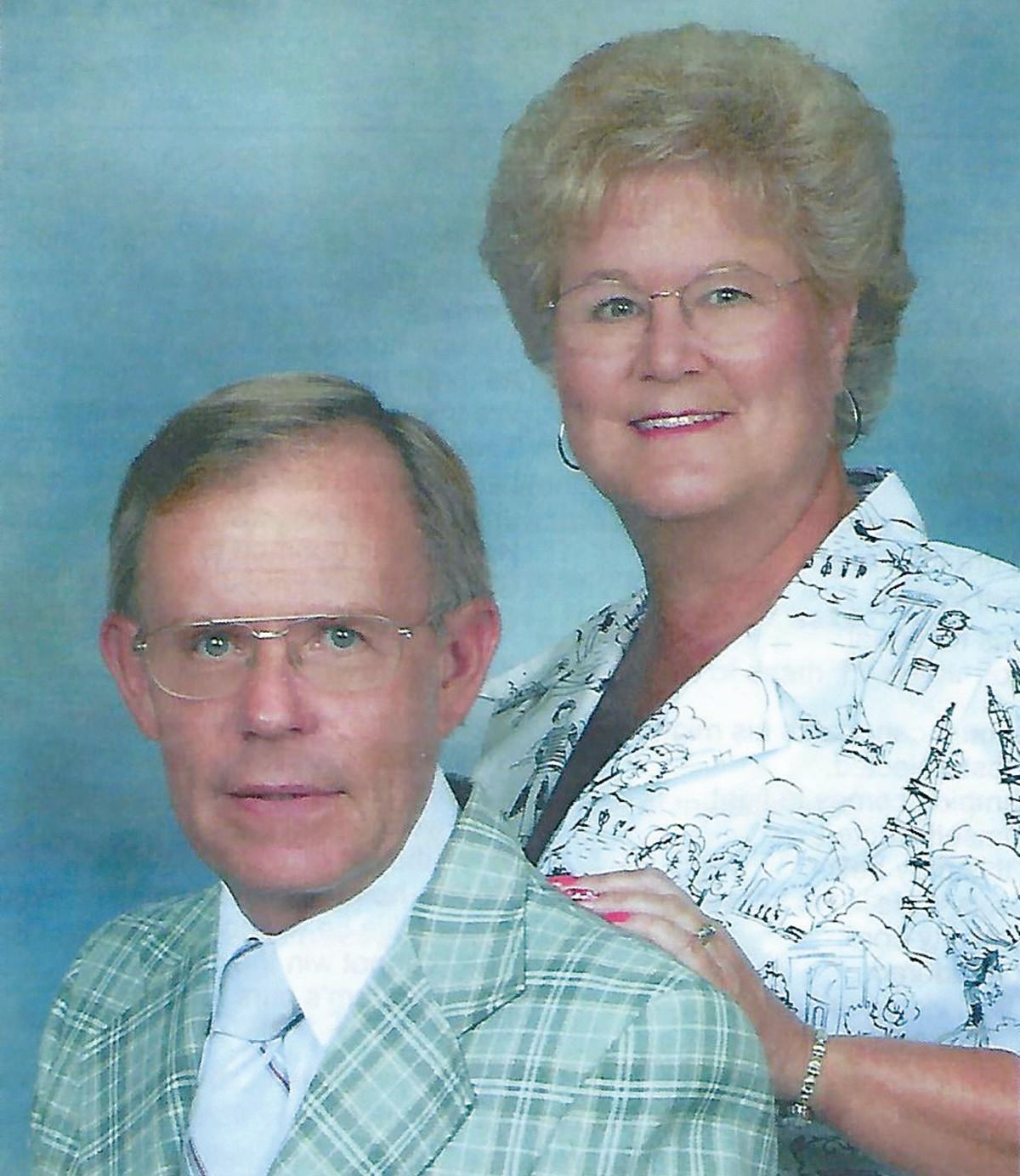
Written By: The officers, board members, and advisors to the MTC

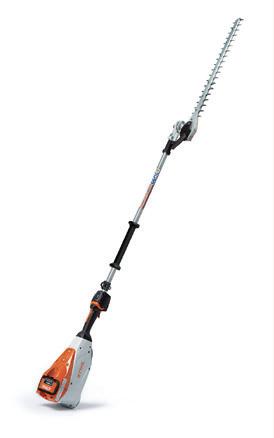



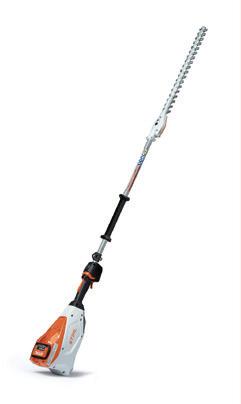
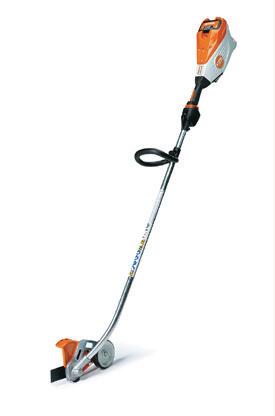

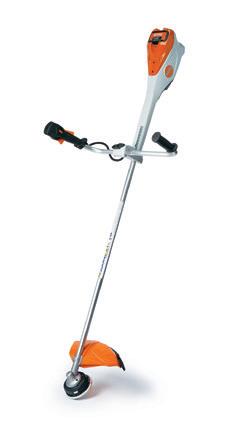

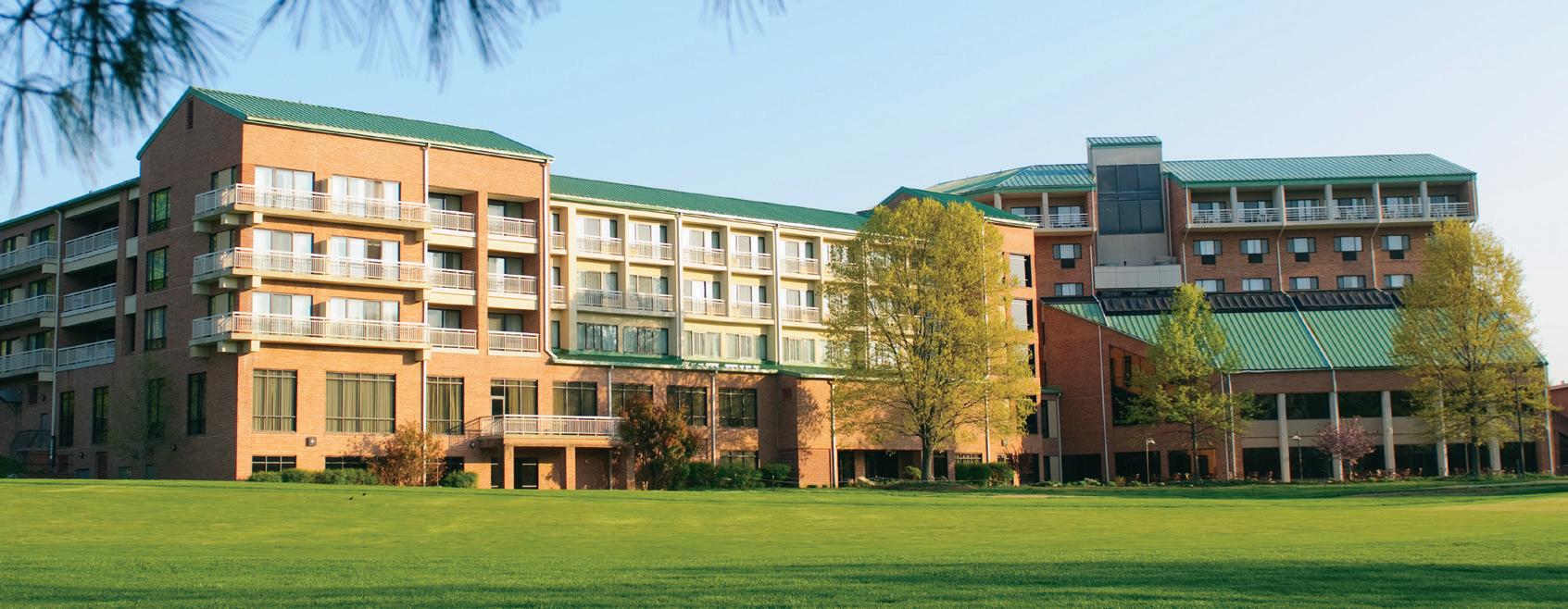

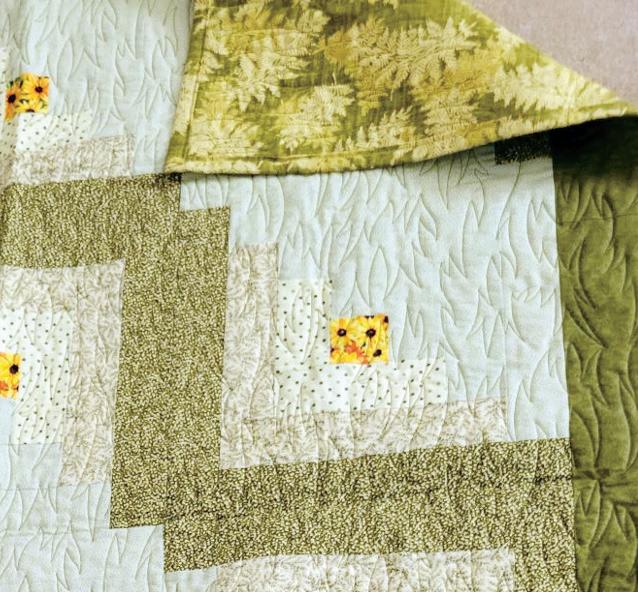
The “GRASSES” quilt raffles have been a real boost to help the MTC support the University of Maryland Turfgrass Programs. Your responses to these raffles have increased each year and last year John Shields was the lucky winner. Our MTC Treasurer, Katy, has designed and created another beauty for this year with Black-Eyed Susan’s as the center square.
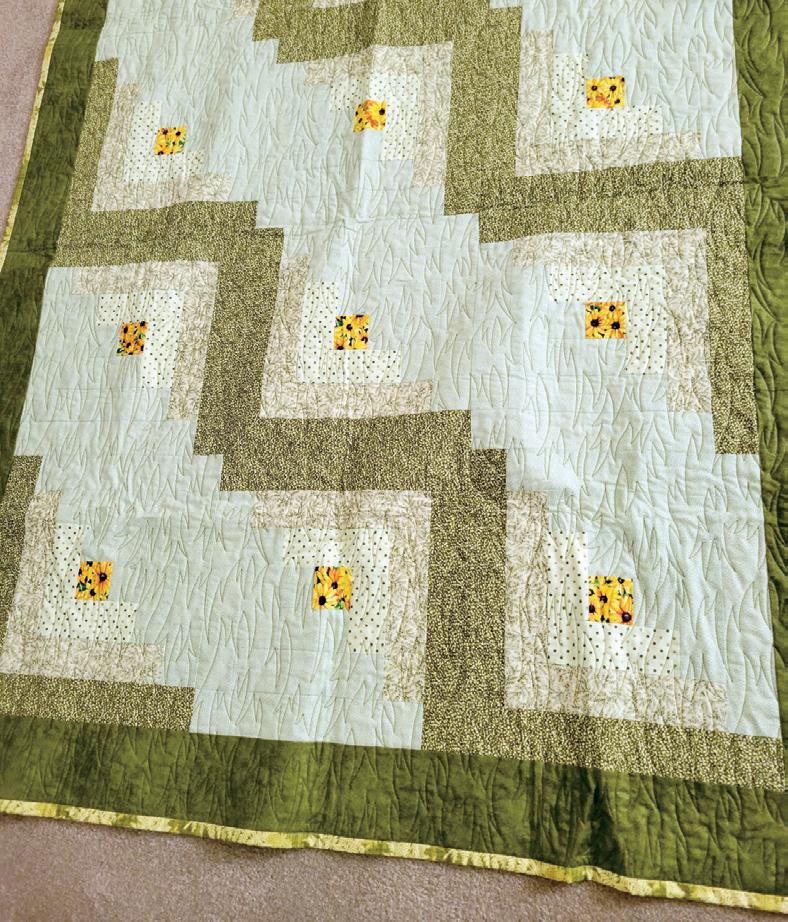
The quilt is approximately 50" x 63" and estimated value is $550 to $600. The winning ticket will be drawn on the Trade Show floor at our Annual Winter Turf grass Conference on Dec. 13, 2022, at Turf Valley but you do not have to be present to win.
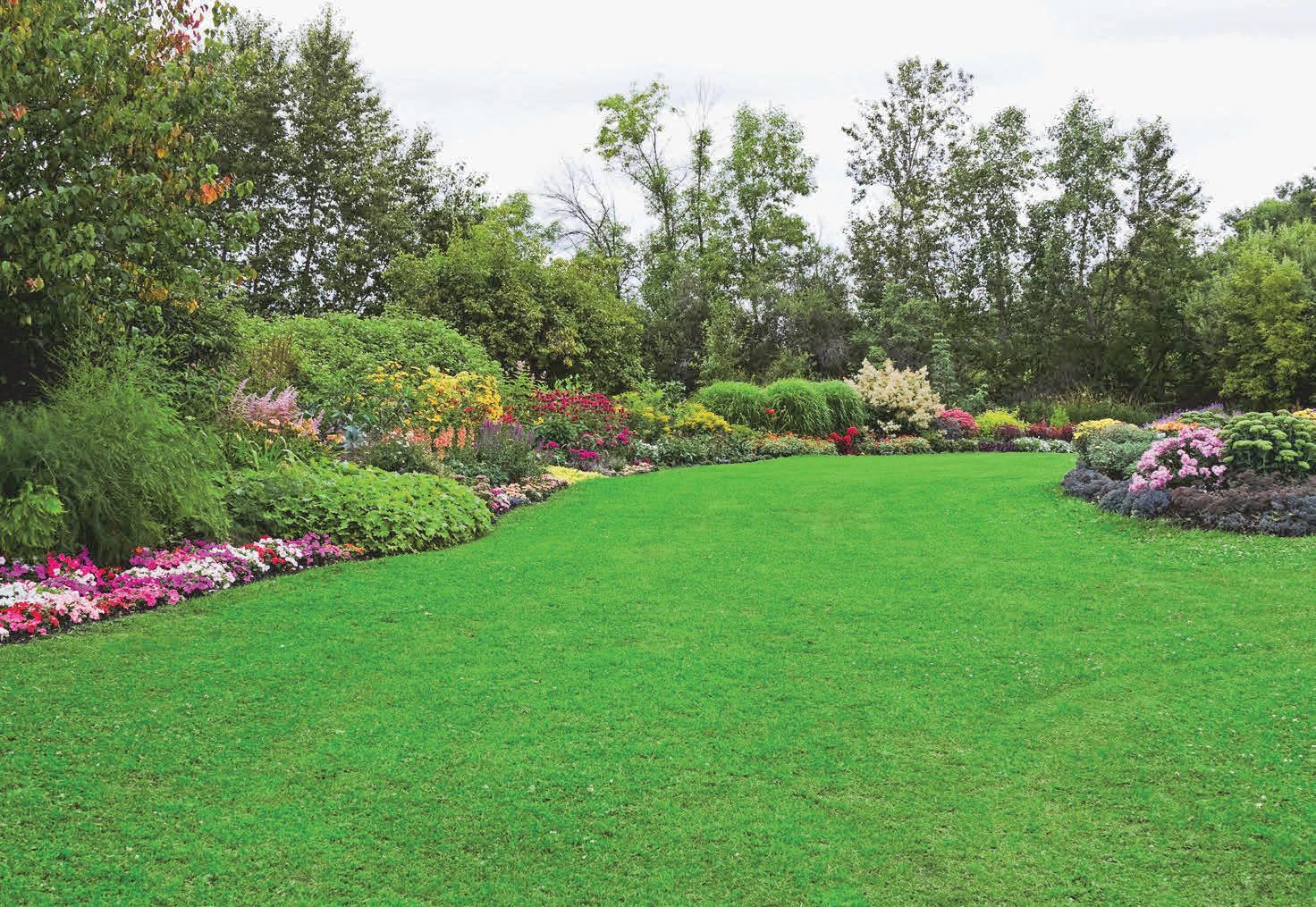


Raffle tickets remain $10 each or 3 for $20 Please mark your choice on the Conference Registration / Membership page.
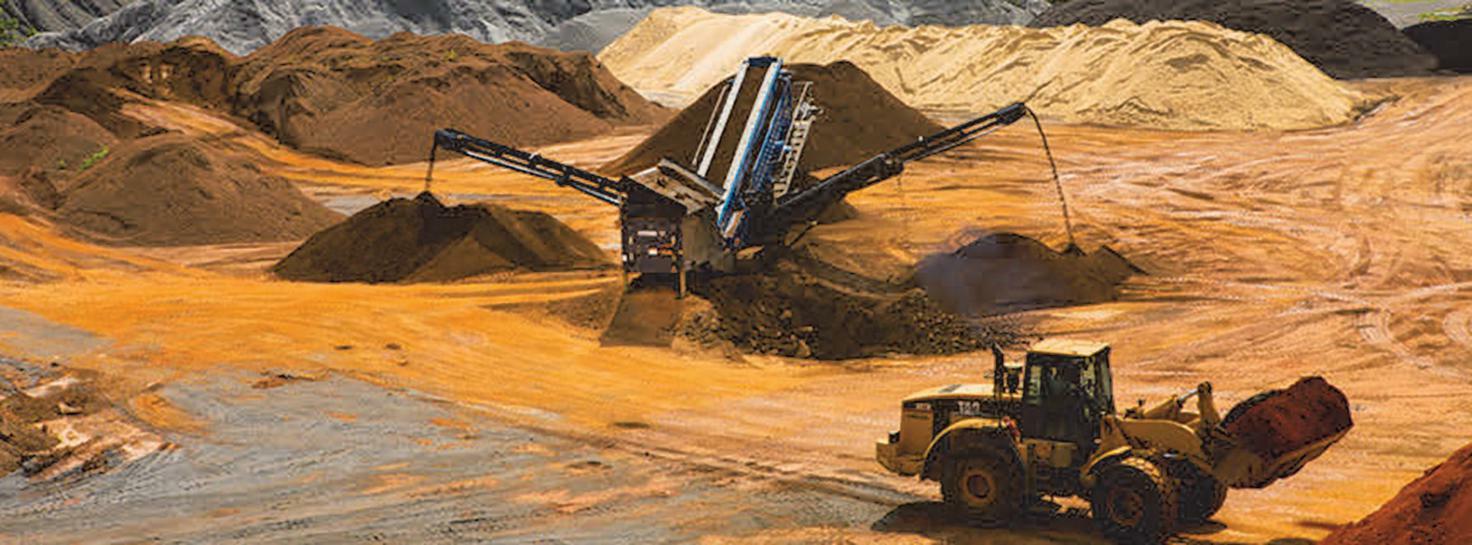
2022 ANNUAL WINTER TURFGRASS CONFERENCE and TRADE SHOW TURF VALLEY RESORT, ELLICOTT CITY, MD
Attendee Name
Company Name
Address
State
| Cell Phone
Do you prefer receiving notices and forms by E-Mail or U.S. Mail?
Pesticide Applicator Recertification: Applying for MD (Cat 3A, 3C, 6, 10, 12), DC, DE, PA, VA, WV
Fertilizer Applicator Recertification: Applying for MD & VA
MD Pesticide License # Last 4 of Social Security #
Other State Pesticide License # What State Category
MD Fertilizer License #PFA - VA Fertilizer License
Please indicate your main emphasis at the conference. You are welcome to move between session tracs. We are only looking for a starting point to sufficiently set-up the rooms. (Please Make a Choice)
Early Pre-Registration November 8, 2022 $90.00 $165.00 Pre-Registration December 6, 2022 $145.00 $220.00 No Pre-Registration Accepted December 6 – 13, 2022 At the Door December 13, 2022 $150.00 $225.00
COVID POLICY for CONFERENCE: Our conference is LIVE this year, however, if you are feeling ill or still having fears of large groups, you can still attend the “Lawn & Landscape Management Track” virtually with zoom. However, you will miss the Trade Show and the networking opportunities the Live Conference offers.
Please indicate here if you wish to attend by Zoom due to large crowd fears. If you feel ill just prior to the conference, contact Vernon at 443-742-6618 by either phone or text and we will try to get you connected.
MAIL or EMAIL or FAX FORM TO: Vernon W. Cooper, Executive Director OR OR Maryland Turfgrass Council 303 S. Talbot St. #389 St. Michaels, MD 21663 ExecDir@MDTurfCouncil.com
Office: 410-745-9643 Fax: 410-745-8867 Cell: 443-742-6618
CONFERENCE SPECIAL: If
are not an MTC member, you may join NOW, and receive the members discount for this year’s conference
and be covered as a member through January 31, 2024, which includes the 2023 conference too.
Members may also renew their dues now for 2023 (MTC dues year is February 1, 2023 to January 31, 2024) if you desire to pay with this year’s funds or you will be invoiced in January 2023
$75
$25
$35 Master
$200 Public Agency
Retiree
$250 Bronze (1 – 5 employees)
$500 Silver (6 – 10 employees)
$1000 Platinum (16 – 20 employees)
$1500 Palladium (21 + employees)
(First 10 employees per County or Location)* $20 each additional employee above 10
We are once again live and hope you will join us as a Vendor and/or Sponsor for the 2022 MTC / University of Maryland’s “Winter Turfgrass Conference and Trade Show” . We will once again be gathering at the Turf Valley Resort in Ellicott City, right off Interstate 70 in Howard County.
Displays will be set-up around the Grand Ball Room where we can all visit and learn of the new products and companies wanting t o display their support of the Turfgrass Industry in Maryland while enjoying a delicious lunch prepared by Alexandra’s Restaurant on site
Trying something new this year. As we all are aware, the price of everything is going up for all of us and unfortunately the cost of booth space is also. However, for those who are willing to commit by Nov. 8th, the cost of the booth spaces will remain the same as last year.
10 x 10 Single
$550 by Nov. 8
$650 by Dec 13 if space permits
10 x 20 Double $1000 by Nov. 8 $1200 by Dec. 13 if space permits
10 x 30 Triple $1500 by Nov. 8 $1800 by Dec. 13 if space permits.
Each 10 x 10 space has an 8’ covered table and 2 chairs, plus each space comes with 2 Badges (additional badges for your company are available for $25 each). Electricity and WIFI are also provided.
MTC’s “Advocate Educational Sponsors” are entitled to a complimentary 10 x 10 booth at no charge.
Due to the ballroom being carpeted, equipment displays are restricted to the outside entrance. If a Vendor has an indoor display booth, there is no charge for displaying equipment outside. If a Vendor chooses only to display outside the fee is same as a single booth above.
Lunch and Trade Show hours have been expanded to 11:45 AM to 1:25 PM with the MTC General Meeting and Elections occurring at the end of lunch. Vendors will have lunch from 11:15 to 11:45 prior to the Trade Show Opening. Following lunch, we will have a speaker discussing “The Benefits of having a MTC Lobbyist” from 1:25-2:00 PM also in the Trade Show Hall.
As of Sept. 25, we have Central Sod Farms, Chesapeake Valley Seed, Genesis Turfgrass Supply, Landscape Supply, Neudorf USA, Newsom Seed and Shore United Bank being Vendors but there is still plenty of room for you. Remember to register before Nov 8 to save.
If you want more visibility for your company and / or want to increase your support of the University Turfgrass Programs, but you prefer not to be a Vendor, then being a “Sponsor” is what you need. There are several different opportunities listed below. Each Sponsorship includes 2 conference passes, and you may purchase additional passes for your company based upon the lists below for $25 each. Each Sponsor will have a banner proudly displaying their support if the sponsorship is committed by Nov. 8. After that date banners will be purchased but we cannot guarantee delivery.
Central Sod Farms is the first, as of Sept. 25, but we can certainly use more.
$550
$1,000

Spring seeding is fraught with problems, but winter is a good time to prepare. Some basics include: getting a soil test; selecting quality seed blends and mixtures; ad dressing seedbed weeds with an appropriate herbicide; ensuring irrigation for dry periods; using composts; and providing erosion control measures. While spring seedings are much more troublesome than those performed in the fall, planning is the key to success. Cost is always a major factor, but a good job can’t be done on the cheap.
Soil testing is a step that too many professionals ignore. For big jobs, it is a must and it’s fast and easy. Getting a handle on soil pH is an important first step since it will greatly influence nutrient availability for many years. The best time to address soil pH extremes (and thus nutrient availability) is just prior to es tablishment when there is bare/open soil. With open ground, you can apply much larger amounts of either pulverized limestone [use where pH is < 6.0] or elemental “flowers” sulfur [use if pH > 7.0] to more effectively address pH extremes. It also is the best time to address nutrient deficiencies (esp. phosphorus). If you wait until after establishment, it may take hundreds of pounds of lime per 1000 sq. ft. applied over a period of years to set things right. A good target number is pH ≈6.5 and a soil test will give you guidelines on amounts of lime needed. DO THIS FIRST and acquire enough lime according to a soil test and incorporate (e.g., apply and till) the lime prior to seeding. (Photo 1)
New construction sites in particular need to be sampled properly since there normally are excavations, trees removed, top soil improperly stock-piled, fill introduced and then ev erything mixed, pushed around and graded. Soil pH can vary greatly, even in a small area if soil is drastically disturbed. For example, in my lawn, an area carved from a wooded lot, I found pH ranging from 4.1 (probably sub-soil moved to the surface) to 5.8 (probably top soil). A big mistake is that too many just grab a spade full of soil for testing. So take the time to get a proper sample from at least three separate areas (i.e., say front,
middle and back). Use a simple soil probe and take a dozen or more random samples from a 3 - 4" depth in each of the three or more separate sites. Other important numbers are those pertaining to phosphorus (P) and potassium (K) levels as well as organic matter percentages. A starter fertilizer is invariably used at seeding and contains a combination of nitrogen (N), P and K. For most purposes, the starter is formulated in roughly a 5:2:1 ratio, but it can vary and the soil test will indicate a proper ratio. The important thing for a spring seeding is to choose a starter that has about 50% of its nitrogen (N) in a slow release form. Phosphorus is another key element that should be applied to bare soil at establishment. (Photos 2 & 3)
The only way to boost organic matter levels in soils is to incorporate a recommended material prior to seeding. The problem is that nobody ever figured out how best to proceed. Indeed, the idea of incorporating topsoil (way too expensive) can be an act of futility. Potential problems with topsoil include the following: without testing how are you to know its pH, nutrient and organic matter content; whether it has a poor ratio of clays and fines; whether it contains heavy metals or salts; etc. Finally, topsoil is heavy and trucking expenses likely will greatly exceed the cost of the soil. (Photo 4)
There was a landmark study conducted at the University of Maryland as it relates to organic matter manipulation in soils of established turf. A seven-year study showed that no matter how much organic fertilizer (Ringer, Sustane and Milorganite) was applied to the turf surface, they had zero impact on boosting organic matter, as well as microbial populations, below the thatch layer and in the root-zone.

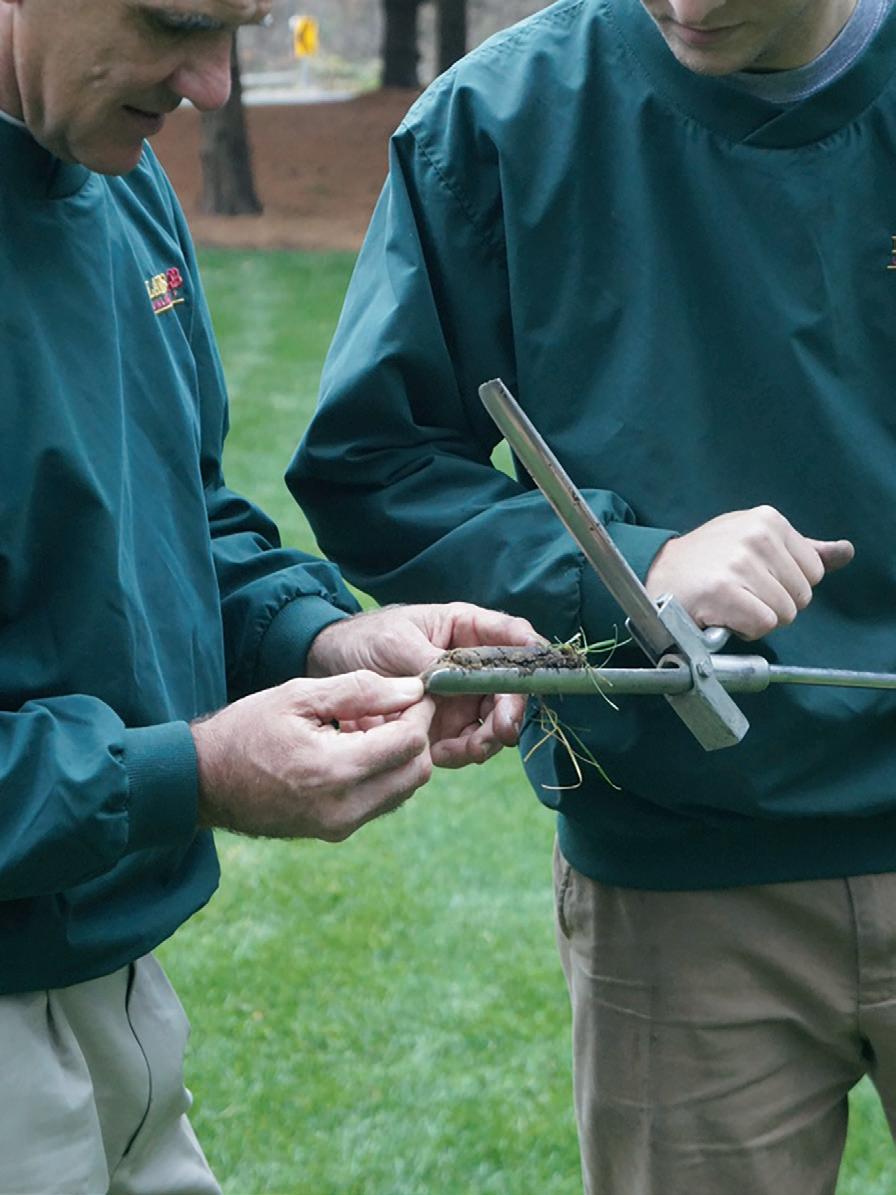
Soil Conditioners: Most soil conditioners are composts and sphagnum peat moss. They are incorporated into poor soils to improve water and nutrient holding capacity. Composts are partially decomposed organic matter and include cow manure, paper mill byproducts, mushroom soils, sewage sludges (aka biosolids); and yard waste materials (composted leaves,
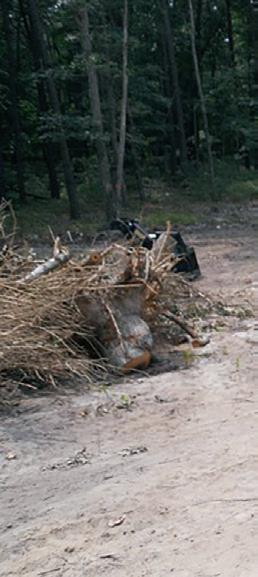
clippings, twigs, chipped branches, etc.) and byproducts of arborists. The most common compost that contains high levels of humus, that I am aware of, is called LeafGro (produced by Maryland Environmental Services, in Montgomery County, MD). LeafGro is the product of very well decomposed grass clipping and yard leaves. It is very dark-almost black in color, has a pleasant earthy odor and contains high levels of humus (thoroughly decomposed organic matter via microbes).
What makes high humus products better than peat moss, and probably other composted materials, is that these products have superior water holding capacity (225% by wt.) and nutrient hold capacity, and freedom of hydrophobic properties. LeafGro is far less expensive than most other soil conditioners (e.g., sphagnum peat, yard and forest composts and similar products).
Peat moss is a primitive plant that contains no vascular system and is comprised of primitive branches, tiny (one cell thick) leaves and root-like rhizoids. Peat can be used in turf as a soil conditioner because it provides improved nutrient and water holding capacities. Peat moss, however, is water repellant (i.e., hydrophobic) and needs to be mixed with a wetting agent. Most products also are mixed with Perlite. Perlite is included since it aides in water infiltration and thus improves aeration. One of the best-known peat moss products is MiracleGro, but there are a multitude of similar sphagnum peat moss products. Peat moss is expensive, compared to organic yard waste composts, and thus is used mostly in potting mixes. (Photo 5)
General information on selection and use of composts can be found in: “Establishment of Lawns with Compost and Micro clover in the Chesapeake Bay Watershed; found by Googling Maryland Turfgrass Council Publications. The publication covers soil modification with composts; noting that a proper material can improve soil structure, increase nutrient and water retention, and provide nutrients. Yard trimmings probably are the most commonly used composts in turf. Yard trimming composts should be dark-brown to black in color, loose and

crumbly, and have an earthy odor (avoid products smelling like ammonia or sulfur). Composts should be free of large, whitishgray undecomposed wood chips (small, degraded/rotted slivers will be present); have a carbon: nitrogen ratio of about 30:1; and a pH range of 6.0 – 7.5.

University of Maryland researchers (Dr. Tom Turner and Dave Funk) performed pioneer work in using LeafGro as a soil condi tioner for turf. To improve soil before seeding/sodding, apply a compost (e.g., LeafGro) to the soil surface with a 1 inch layer (3 cubic yards/1000 sq ft) or 2 inch layer (6 cu.yrds. /sq. ft.). The compost needs to be incorporated via rototilling into the upper 4 to 6 in. of soil, which is easier said than done. Using more than a 2" topical layer is extremely difficult to properly mix into the upper 4 – 6" soil. Excessively wet composts and/or soils cannot be thoroughly mixed. It is important that the compost be thoroughly mixed and not allowed to form clumps and layers. (Photo 6)
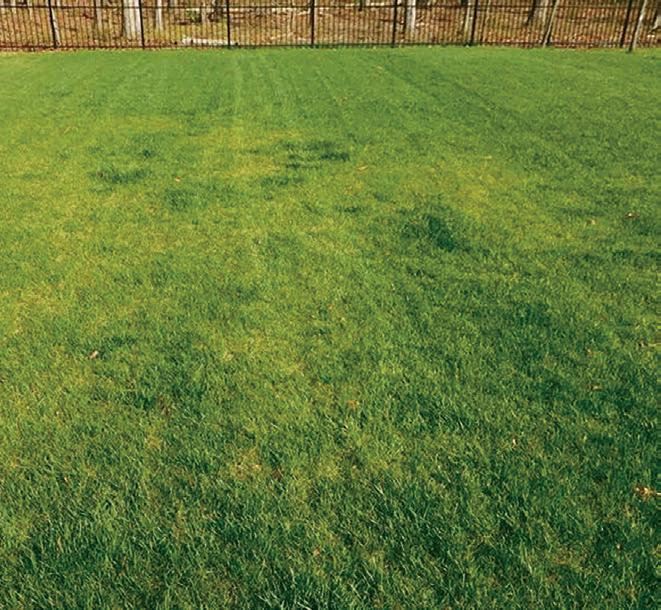

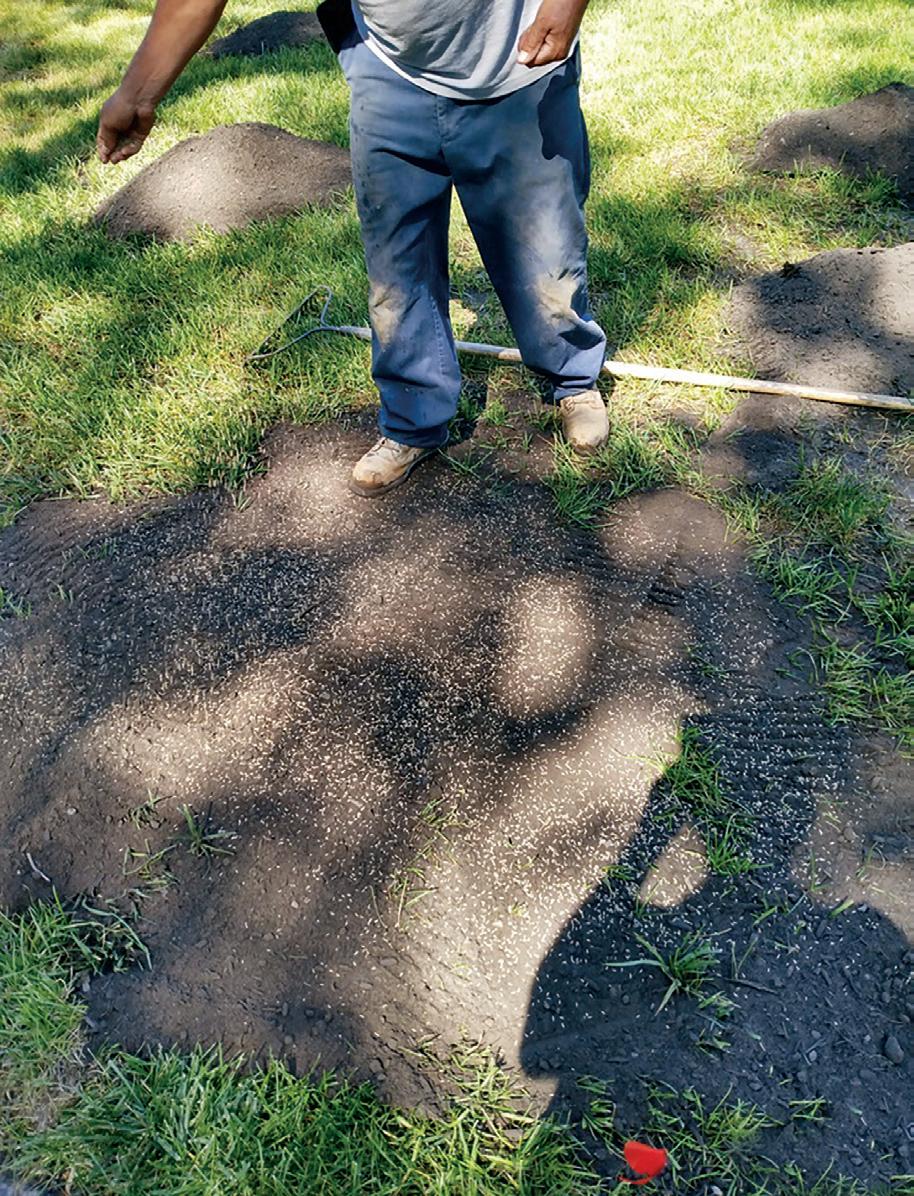
Seed Selection: For most situations, including lawns, roughs, sod production, sports fields and other professionally managed areas, a blend 2 or 3 cultivars of tall fescue mixed with about 3 to 5% Kentucky bluegrass is best. Regionally adapted turf cultivars for mixes can be obtained from any County Ex tension office. In DE and MD, use University of Maryland’s TT77 “Recommended Turfgrass Cultivars for Certified Sod Production and Seed Mixtures in Maryland (Google Maryland Turfgrass Council Publications).
Spring Seeding and Herbicides: There are too many scenarios to address here as it relates to seedbed preparation. Tilling, leveling, incorporating a recommended organic product (es pecially helpful in sandy as well as clay sub-soils) and firming are the basics. Assuming a uniform grade, killing existing veg etation and disk/drill seed also works well. After the seedbed has been prepared, it is very important to apply a seedbed-safe preemergence herbicide like Tenacity (mesotrione) or Tupersan (siduron). The reason being is that the most common cause for spring seeding failures comes from weed competition.
While Tupersan is highly effective on crabgrass and foxtails, it has little or no impact on broadleaf weeds and sedges. Tenacity has been a major game changer in successful spring seedings because it safely targets a multitude of common broadleaf and sedge weeds as well as crabgrass. For best results, apply Te nacity at or just after seeding and then apply a second time four to six weeks later. Use a high label Tenacity rate (e.g., 6 oz. product/acre) if seeding into Round-up-killed vegetation. It works wonders in reducing weed competition, thus allowing seedlings to tiller and for stands to mature more rapidly. Note: Tenacity is highly toxic to bentgrasses. When seeding bentgrass, use Tu persan in the seedbed for safe and effective pre-emergence control

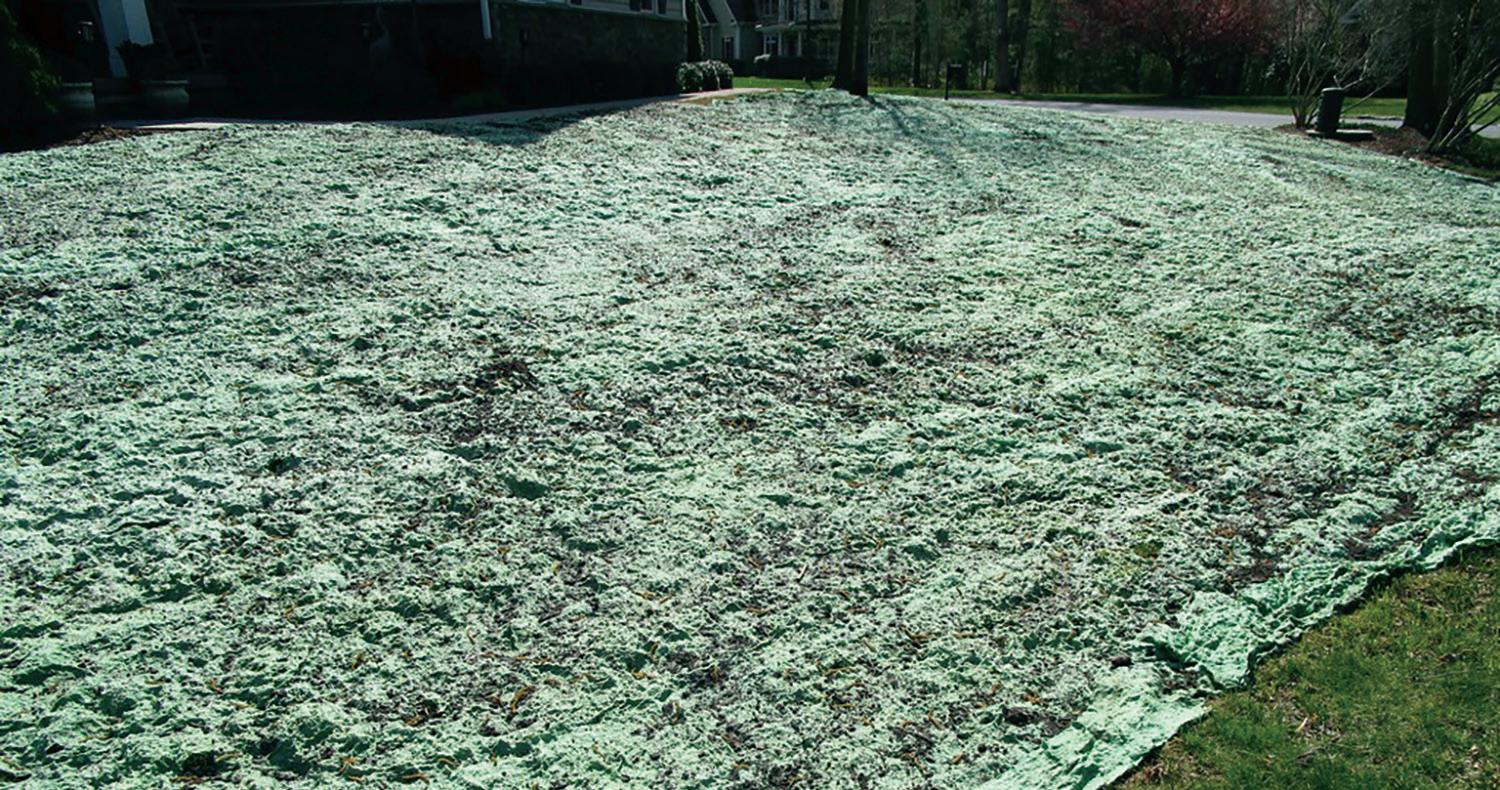
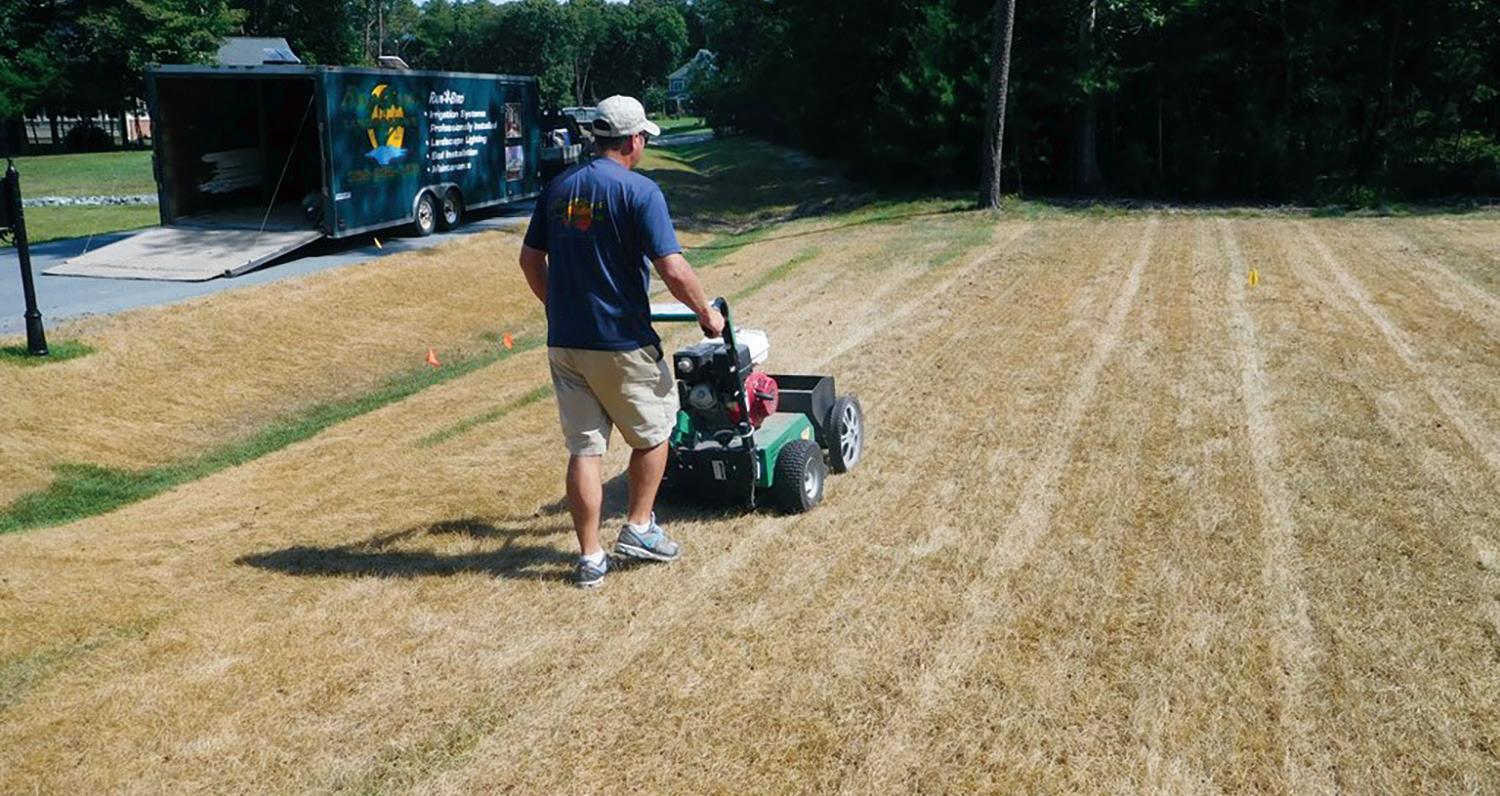
of crabgrass and foxtails (not likely to control goosegrass or broadleaf weeds). Tenacity use will easily pay for itself; factoring in labor, time and costs to purchase and apply different herbicides targeting broadleaf and annual grass weeds. Tenacity is safe to use on cool-season grass seedlings (except bentgrass), but can bleachdiscolor and/or thin seedlings if excessive rates are applied (e.g., in overlaps, etc.). (Photos 7, 8, 9, 10 & 11)
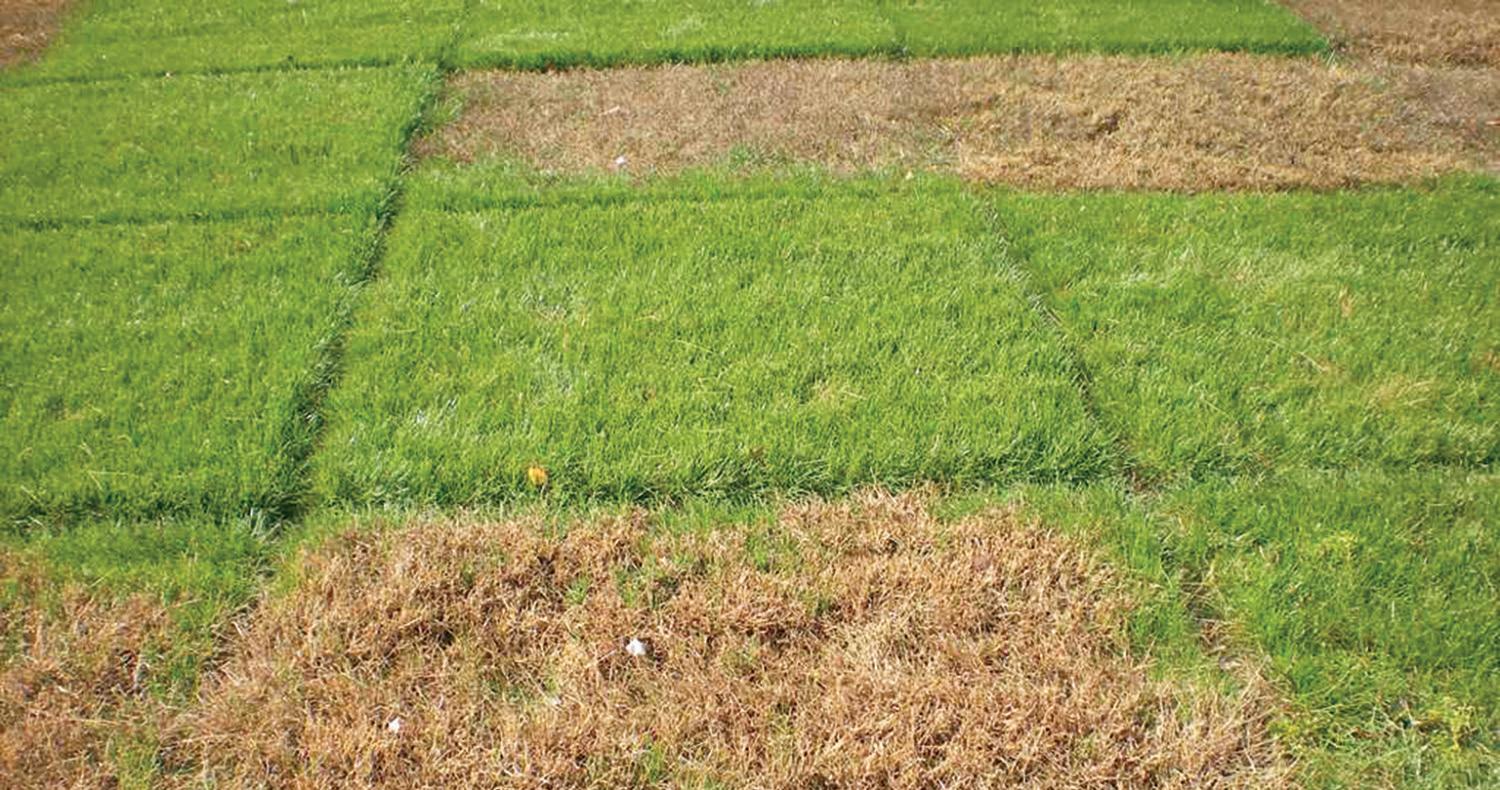
Irrigation can be a wild card. If available, it will greatly enhance success. In our region, irrigation generally is not needed in the spring until seedlings emerge. Seedling emergence is governed mostly by soil temperature in spring and timely rains that keep the seedbed moist. In general, it is best to wait until mid-April to
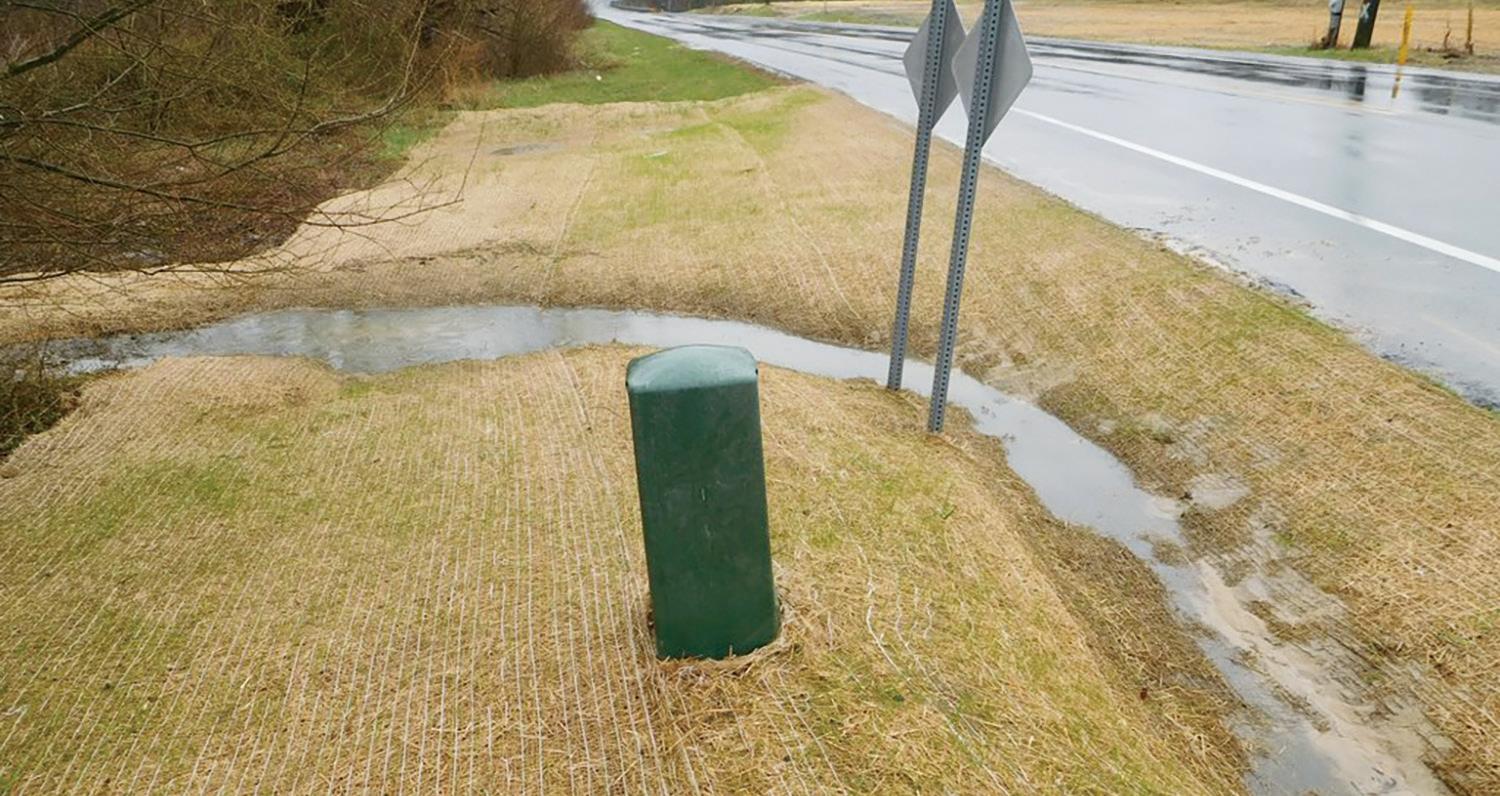
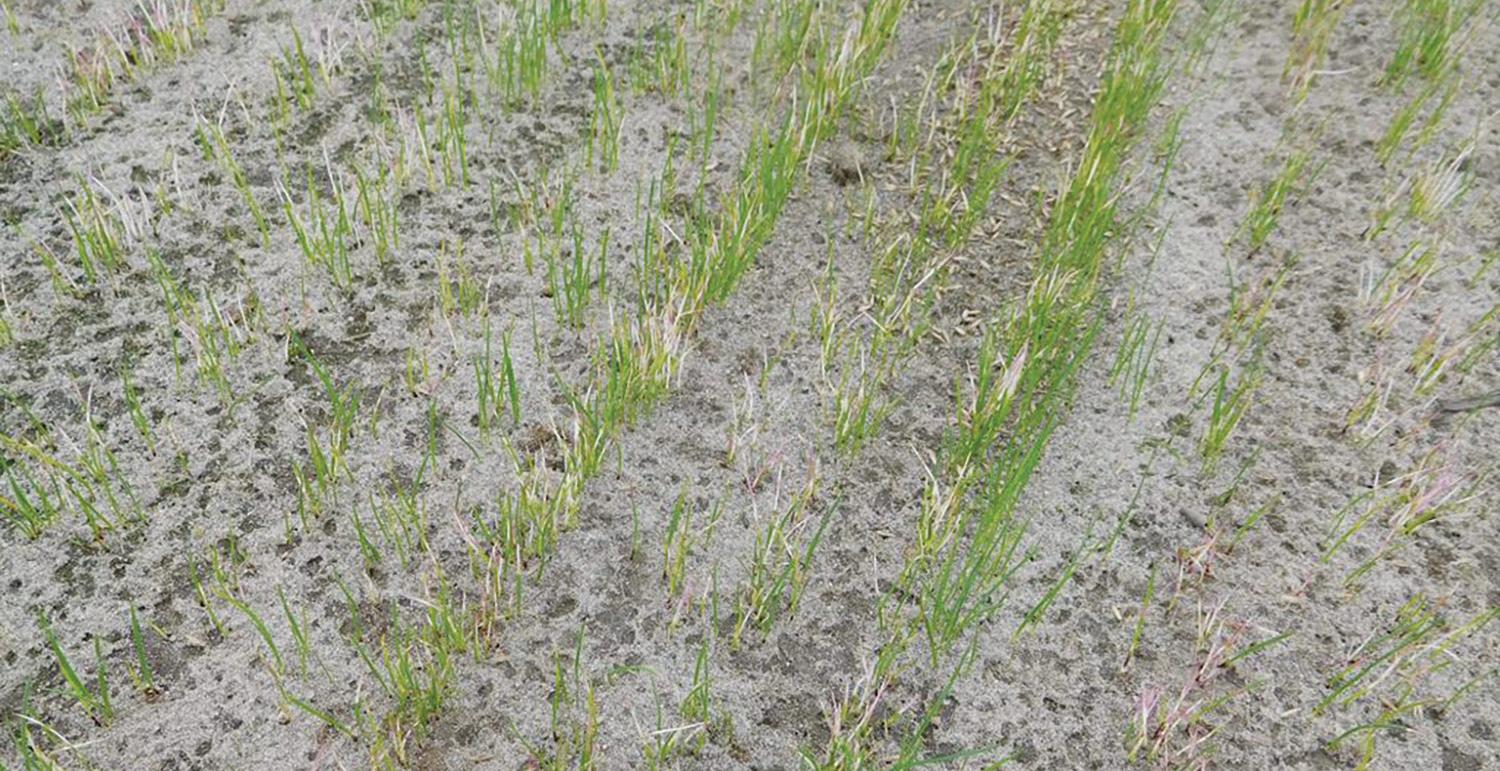
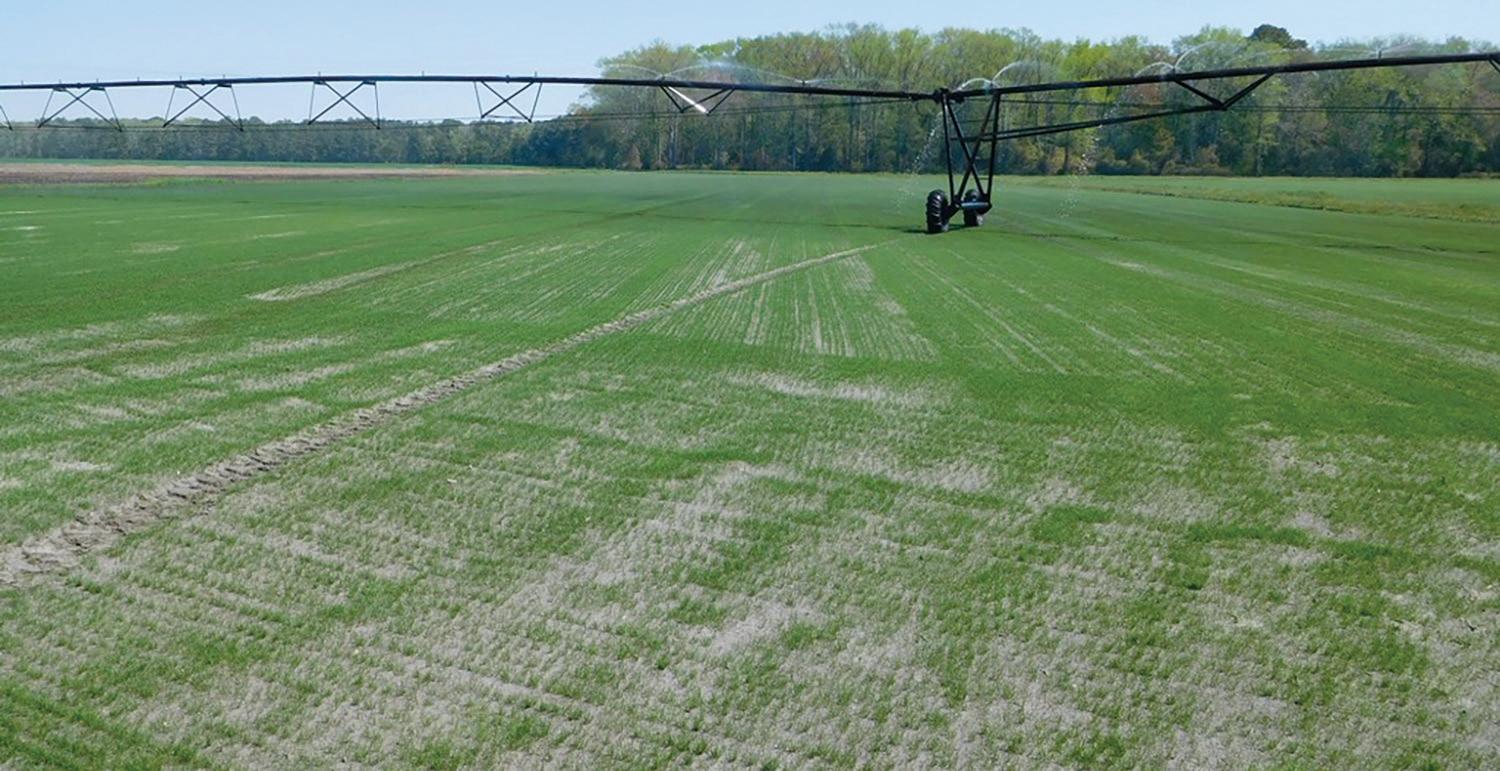

seed to ensure soil temperatures are warm enough to promote turfgrass seed germination. Irrigation should be withheld as long as soils are moist, which again is likely to be the case in most springs. What you need to worry about most is the potential of soil erosion and seed washing in response to spring rain deluges. If the area is mostly bare soil that is prone to erosion (e.g., slopes), the site should be top-dressed by lightly scattering either straw (make sure you have a reliable weed-free source), compost or straw/ paper blankets. (Photo 12)
Mulching newly planted seedbeds helps to retain moisture, moderates temperature, and reduces erosion (i.e., movement of seed and soil off-site due to heavy rain events). Straw comes in bales of cereal grains (e.g., wheat, rye, barley or oats). Any small amount of cereal seed present will actually be helpful. Grains germinate fast and help to hold soil in place, yet plants die out quickly when mowed. Straw should be applied/sprinkled to ensure there are sufficient openings to the soil surface, which allows for sunlight penetration. Too much straw could promote disease or cause weak and spindly growth; whereas too little will not help retain soil moisture or prevent erosion. Rates of 80 to 100 lb straw per 1000 sq.ft. (a bale weighs about 35 lbs). Steep slopes may require more straw, and in some cases netting or string-tie-downs to hold straw in place. Straw should be raked /blown or otherwise removed once stands have good density.
There also are numerous “straw blanket” products on the market, which often are utilized by profes sionals when soils get cold from late fall (Nov.) to early spring (March). On severe slopes, and in water drainage patterns and swales, straw blankets may be the best option in preventing excess erosion. Straw blankets are weed free, effective and should have at least a six-month durability onsite; hence, they are much more expensive to use versus straw bales. For small patchwork, yard trimming composts are effective (e.g., LeafGro). Simply apply about one inch of compost over bare areas; apply liberal amounts of seed (like peppering a steak); rake seed in and lightly tamp. (Photos 13 & 14) •
